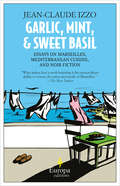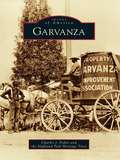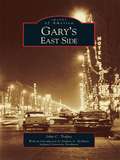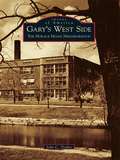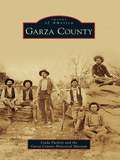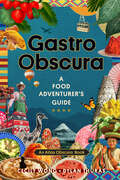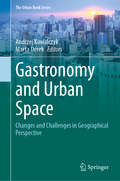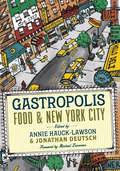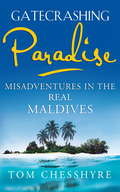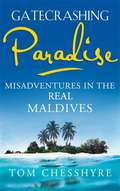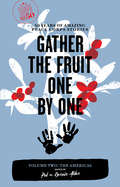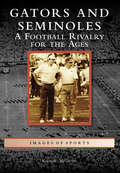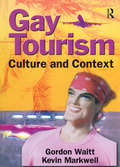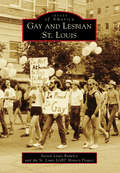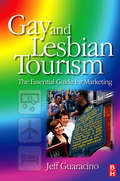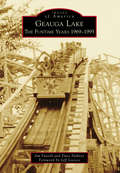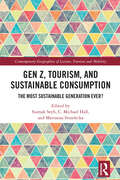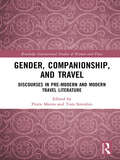- Table View
- List View
Garlic, Mint and Sweet Basil: Essays on Marseilles, Mediterranean Cuisine, and Noir Fiction
by Howard Curtis Jean-Claude IzzoAvailable for the first time in English in Howard Curtis's brilliant translation this collection of personal essays shows Izzo at his most contemplative and insightful. He writes beautifully about the city he loved, the sea to which he belonged, and the literary movement that made him famous. A must-read for all lovers of Izzo's Marseilles Trilogy.
Garvanza (Images of America)
by Highland Park Heritage Trust Charles J. FisherNamed for the garbanzo bean that Julio Verdugo raised on his Rancho San Rafael, the town of Garvanza was laid out by Ralph Rogers in 1886. The community soon became a haven for artists and others seeking a refuge from the growing urban life of Los Angeles. Early institutions included the Church of the Angels and the Judson Studios, founded by painter William Lees Judson to create art through stained glass. The town's identity was eventually overtaken by neighboring Highland Park, but the community name was reestablished in the 1990s by today's residents, who are as in love with its beauty as those 110 years earlier.
Gary's East Side
by John C. Trafny Stephen G. McshaneGary's East Side is a nostalgic look back at one of the Steel City's oldest neighborhoods. Through a captivating collection of photographs that chronicle the many aspects of life on the east side of Gary, the book presents the rich history of the community from 1906, the year of Gary's founding, to the present.From the steel mills to the churches to Gary's City Hall, Gary's East Side offers a touching look at this close-knit community. The east side of Gary was a place where people knew their neighbors, where children went to school together, and married high school sweethearts. The area has changed, but a new Gary is emerging. Gary's East Side presents the history of this area in poignant detail and points to the heartening future. Author John Trafny's skillful compilation promises to bring back fond memories of this historic neighborhood.
Gary's West Side: The Horace Mann Neighborhood (Images of America)
by John C. TrafnyThough Gary was an industrial city founded by U.S. Steel, the Horace Mann neighborhood evolved into one of the most exclusive residential areas in northwest Indiana. Skilled craftsmen from the mills were able to live among doctors and lawyers as well as businessmen and supervisors from U.S. Steel. From the boom years of the 1920s through the 1960s, residents of diverse economic backgrounds sent their children to the same schools, prayed together in the same houses of worship, and shopped in Gary's popular downtown. Gary's West Side: The Horace Mann Neighborhood is a pictorial history spanning four generations of one of the Steel City's premier residential districts. Through archival photographs, family snapshots provided by former residents, and shared memories, the reader is taken on a nostalgic journey from the city's founding in 1906 through to the 21st century.
Garza County (Images of America)
by Garza County Historical Museum Linda PuckettGarza County was created in 1876 and named by Texas legislators in honor of the de la Garza family of San Antonio. The county lay claim to vast ranch lands with the picturesque cap rock escarpment weaving its way from north to south. Though the 1880 census listed the population as a sparse 36 people--mostly landowners and cowhands--cattlemen like John B. Slaughter and W. E. Connell owned massive spreads in excess of 100,000 acres with more than 5,000 head of cattle and 100 horses. By 1900, the population had grown to 180, with only 545 acres in cultivation. Things changed with the arrival of cereal magnate C. W. Post, who came to Garza County to begin building his model town and experimental farming campaign. On June 15, 1907, an election to organize the county was held and Post City became the official county seat, touting the slogan "Gateway to the Plains."
Gastro Obscura: A Food Adventurer's Guide (Atlas Obscura)
by Cecily Wong Dylan Thuras Atlas ObscuraTaste the World! It&’s truly a feast of wonder: Created by the ever-curious minds behind Atlas Obscura, this breathtaking guide transforms our sense of what people around the world eat and drink. Covering all seven continents, Gastro Obscura serves up a loaded plate of incredible ingredients, food adventures, and edible wonders. Ready for a beer made from fog in Chile? Sardinia&’s &“Threads of God&” pasta? Egypt&’s 2000-year-old egg ovens? But far more than a menu of curious minds delicacies and unexpected dishes, Gastro Obscura reveals food&’s central place in our lives as well as our bellies, touching on history–trace the network of ancient Roman fish sauce factories. Culture–picture four million women gathering to make rice pudding. Travel–scale China&’s sacred Mount Hua to reach a tea house. Festivals–feed wild macaques pyramid of fruit at Thailand&’s Monkey Buffet Festival. And hidden gems that might be right around the corner, like the vending machine in Texas dispensing full sized pecan pies. Dig in and feed your sense of wonder. &“Like a great tapas meal, Gastro Obscura is deep yet snackable, and full of surprises. This is the book for anyone interested in eating, adventure and the human condition.&” –Tom Colicchio, chef and activist &“This exquisite guide kept me at the breakfast table until dinner time.&” –Kyle Maclachlan, actor and vintner
Gastronomy and Urban Space: Changes and Challenges in Geographical Perspective (The Urban Book Series)
by Andrzej Kowalczyk Marta DerekThis book focuses on the relationship between gastronomy and urban space. It highlights the intrinsic role of eating establishments and the gastronomy industry for cities by assessing their huge impacts on urban changes and discussing some of the challenges posed by new developments.Written by authors with a background in geography, it starts by discussing theoretical aspects of studies on gastronomy in urban space to place the subject in the broader context of urban geography. Covering both changes and challenges in gastronomy in urban space, it presents a wide range of problems, which are described and analysed using various case studies from Europe and other parts of the world.
Gastropolis: Food & New York City (Arts and Traditions of the Table Perspectives on Culinary History)
by Hauck-Lawson, Annie S., and Jonathan Deutsch, eds. Foreword by Michael LomonacoThis irresistible sampling of NYC&’s rich food heritage takes readers on a cultural and historical journey from Brooklyn to the Bronx and beyond. Whether you're digging into a slice of cherry cheesecake, burning your tongue on a piece of Jamaican jerk chicken, or slurping the broth from a juicy soup dumpling, eating in New York City is a culinary adventure unlike any other in the world.Gastropolis explores the historical, cultural, and personal relationship between New Yorkers and the food they eat. Beginning with the origins of local favorites, such as Mt. Olympus bagels and Puerto Rican lasagna, the book looks back to early farming practices and the pre-European fare of the Leni Lenape. Essays trace the function of place and memory in Asian cuisine, the rise of Jewish food icons, the evolution of food enterprises in Harlem, the relationship between restaurant dining and identity, and the role of peddlers and markets in guiding the ingredients of our meals. Touching on everything from religion to nutrition; agriculture to economics; and politics to psychology, Gastropolis tells a multifaceted story of immigration, amalgamation, and the making of New York&’s distinctively delicious flavor
Gatecrashing Paradise
by Tom ChesshyreAway from the five-star hotels and beyond luxury hideaways, Tom Chesshyre travels to see the real, unexplored Maldives, skirting around the archipelagos periphery, staying at simple guesthouses, and using cargo ships and ferries. He discovers that beyond the glossy brochures lies an almost undiscovered country that is brimming with life, yet also a paradise teetering on the brink of trouble.In the Maldives outsiders used to be banned from islands not officially endorsed as tourist resorts, but now a thousand sandy shores can be visited in this remote nation deep in the Indian Ocean the flattest on Earth.This is island-hopping for the twenty-first century, sailing around 600 miles of the most beautiful islands and atolls on Earth, often to communities that have not seen an outsider for decades, ...and gatecrashing the odd posh hotel.On my journey this nation had proved to be by turns blissful, troubled, joyous, delicious, fraught, and always very, very watery. With the blazing sunsets, gyrating currents in deserted lagoons, kaleidoscopes of coral, cascades of fish, crescents of perfect white sand, peaceful coral stone villages, emerald jungle...the Maldives has to be one of the most beautiful, colourful and sometimes complicated places on the planet.A whole new country had effectively opened up, hundreds of islands seldom seen by outsiders. It is not all that often something like this happens in the twenty-first century. I was looking forward to making the most of paradise, and I was intending to take a voyage around the edges of perfection.
Gatecrashing Paradise: Misadventure in the Real Maldives
by Tom ChesshyreAway from the five-star hotels and beyond luxury hideaways, Tom Chesshyre travels to see the real, unexplored Maldives, skirting around the archipelago's periphery, staying at simple guesthouses, and using cargo ships and ferries. He discovers that beyond the glossy brochures lies an almost undiscovered country that is brimming with life, yet also a paradise teetering on the brink of trouble.In the Maldives outsiders used to be banned from islands not officially endorsed as tourist resorts, but now a thousand sandy shores can be visited in this remote nation deep in the Indian Ocean the flattest on Earth.This is island-hopping for the twenty-first century, sailing around 600 miles of the most beautiful islands and atolls on Earth, often to communities that have not seen an outsider for decades, ...and gatecrashing the odd posh hotel.
Gatecrashing Paradise: Misadventure in the Real Maldives
by Tom ChesshyreAway from the five-star hotels and beyond luxury hideaways, Tom Chesshyre travels to see the real, unexplored Maldives, skirting around the archipelago's periphery, staying at simple guesthouses, and using cargo ships and ferries. He discovers that beyond the glossy brochures lies an almost undiscovered country that is brimming with life, yet also a paradise teetering on the brink of trouble.In the Maldives outsiders used to be banned from islands not officially endorsed as tourist resorts, but now a thousand sandy shores can be visited in this remote nation deep in the Indian Ocean the flattest on Earth.This is island-hopping for the twenty-first century, sailing around 600 miles of the most beautiful islands and atolls on Earth, often to communities that have not seen an outsider for decades, ...and gatecrashing the odd posh hotel.
Gather the Fruit One by One: 50 Years of Amazing Peace Corps Stories
by Bernie Alter Pat AlterTake some Inca, Aztec, Maya, and Moche, mix in Spanish, French, English, Dutch and Danish, stir it to the rhythmic beat of Africa and what do you get? A zesty brew, expressed in a callaloo soup of language, food, music, and religion. So much passion, so much sorrow. What seems familiar in the Americas often is not. For Peace Corps Volunteers, there is nothing to do but learn the language, roll up their sleeves, and get busy working alongside strangers who steal their hearts away. These stories take you on overland journeys to the Amazon Basin, into a village in Honduras terrorized by insurgent forces, and to the ball fields of Ecuador for an unusual game of "beisbol."
Gators and Seminoles: A Football Rivalry for the Ages (Images of Sports)
by Kevin M. MccarthyThe University of Florida and Florida State University are two of the best institutions of higher learning in the third most populous state in our country. They cooperate in many academic ventures and have joint programs, especially in the sciences. They do not, however, cooperate in athletic endeavors and, in fact, compete fiercely in all sports, especially football. Since 1958, when they first started playing football against each other, they have met 60 times, twice in postseason bowl games, one of which was for the national championship. The two teams have each had three Heisman Trophy winners and have won the national championship in Division I a total of 13 times: five for Florida and eight for Florida State. This then is the story of one of this country's fiercest football rivalries, complete with outstanding players and coaches, as well as controversies.
Gay Tourism: Culture and Context
by Gordon Waitt Kevin MarkwellThe gay tourism industry-a progressive social force or a pull towards an oppressive status quo?The pink tourism dollar is now recognized as a highly profitable niche of the tourism market. Gay Tourism: Culture and Context critically investigates the emergence of a commercial gay tourism industry for male clients, the way it is organized, and how the tourism industry promotes cities, resorts, and nations as &’gay&’ destinations. This careful examination critically questions the social, political, and cultural implications regarding relationships between gay tourism, Western gay male culture, the erotic, sexual politics, and sexual diversity.Gay Tourism: Culture and Context begins by detailing how travel often enabled the expression of Western same-sex male desire in the nineteenth century and then charts the emergence of a Western gay tourism industry in the late twentieth century. A critical analysis is given of gay guidebooks and erotic videos that help to establish and maintain destinations as seemingly gay utopias, including Hawaii and the Greek island Mykonos. Carefull consideration as to debates about how the gay tourism industry operates in the context of questions regarding the globalization of sexuality, sexual citizenship and place-marketing of (homo)sexualised cities. The text includes an extensive bibliography plus several photographs, charts, and figures to clearly present concepts and ideas.Topics in Gay Tourism: Culture and Context include: the history of gay travel and tourism the effect of HIV/AIDS on gay tourist destinations gay travel writing sustaining same-sex fantasies about popular gay tourist destinations analysis of the socio-political ramifications of gay tourism the sexual politics of a heterosexual nation gay tourists as an "invading force" of corruption the economic rationale for the (homo)sexualized city the concept of "gay villages" the role of special events and festivals in gay tourism and many more!Gay Tourism: Culture and Context is enlightening reading for tourism policymakers, tourism planners, tourism managers, and teachers and students in the fields of tourism studies, gay studies, social and cultural geography, and sociology.
Gay and Lesbian Philadelphia (Images of America)
by Thom NickelsThe diverse landscape of gay and lesbian Philadelphia is a story of highs and lows. From rustic post-Civil War days when Camden poet Walt Whitman crossed the Delaware River on a ferry or caroused Market Street "eyeing" the grocery boys, to the beginnings of ACT UP more than one hundred years later, the gay and lesbian community in Philadelphia has never lost its flair for the dramatic.Gay and Lesbian Philadelphia is a historical look at the neighborhoods, events, and people that have been a part of this community. The 1920s saw the birth of private dance bars on Rittenhouse Square. It was a time when drag shows in straight bars were the order of the day, as was the presence of men in drag during the annual Mummer's Parade on New Year's Day. The pre-Civil Rights era, when segregation was the status quo, saw the proliferation of African American house parties in neighborhoods such as North Philadelphia, where black gays and lesbians formed a community. During the 1950s and 1960s, Rittenhouse Square was the site of informal public gatherings. These gatherings of friends and strangers helped set the stage for the Annual Reminder, the first public protest in support of "homosexual equal rights," which took place every Fourth of July at Independence Hall. Throughout all of these eras, members of the community faced challenges, celebrated victories, and continued to try to blend their lives with those of their gay and straight neighbors.
Gay and Lesbian St. Louis (Images of America)
by St. Louis LGBT History Project Steven Louis BrawleyIn the late 19th century, St. Louis--America's fourth-largest city--was a hub of robust commerce and risqué entertainment. It provided an oasis for those who lived "in the shadows." Since 1764, the Gateway to the West's LGBT community has experienced countless struggles and successes, including protests, arrests, murders, celebrations, and parades. St. Louis had its own version of Stonewall in October 1969 and is the hometown of icons such as Tennessee Williams and Josephine Baker. A colorful array of activists, drag queens, leather men, artists, academics, business leaders, and everyday folks have contributed to the rich fabric of the lesbian and gay community in St. Louis.
Gay and Lesbian Tourism
by Jeff GuaracinoThis unique introductory resource provides a broad foundation of knowledge on the gay and lesbian market segment. Topics and themes are illustrated by interviewing the top professionals in gay travel and gay media who share their experience, tips for success and future predictions. Packed with best case examples and practices of existing gay tourism initiatives and campaigns, this engaging text provides analysis and context that addresses some of the burning questions in this area, including the potential negative consumer and stakeholder reaction, and strategies to educate the local hospitality community.
Geauga Lake: The Funtime Years 1969-1995
by Jim Futrell Dave Hahner Jeff LococoIn 1968, three businessmen left their jobs at Cedar Point in Sandusky to purchase Geauga Lake Amusement Park. Geauga Lake had been a summertime escape since the 1870s, but by the 1960s it had fallen on hard times. The businessmen's company, Funtime, Inc., transformed the aging facility into a modern amusement park and established a reputation as an innovative operator in one of the nation's most competitive amusement park markets. Geauga Lake became the first park with two looping roller coasters and the first to integrate a full-scale water park, Boardwalk Shores. The company broke even more new ground in 1988 when it resurrected a classic roller coaster design to construct Raging Wolf Bobs. Images of America: Geauga Lake: The Funtime Years 1969-1995 captures the park's transformation and some of the countless memories that resulted from Funtime's 26-year ownership.
Geek Silicon Valley: The Inside Guide to Palo Alto, Stanford, Menlo Park, Mountain View, Santa Clara, Sunnyvale, San Jose and San Francisco
by Ashlee VanceSilicon Valley veterans and newbies alike will want to explore this book that delves into the rich history behind the region that birthed the world's most important industry. Technology journalist Ashlee Vance has captured almost every aspect of the area stretching between San Francisco and San Jose, California, starting with the eager radio and electronics enthusiasts of the early 1900s and ending with the computing powerhouses of today such as Google and Apple. Along the way, the book profiles the people and places that have elevated Silicon Valley to an almost mythic pedestal. This book delivers Silicon Valley, taking us from success story to failed startup and back again as we drive the roads from San Francisco to Menlo Park, Palo Alto, Mountain View, Sunnyvale, Santa Clara and San Jose. It's full of profiles of the larger-than-life characters that pioneered the processor, computer, and Internet revolutions. The book's vibrant design includes "Silicon Valley Soundbytes" packed with insider information and trivia, and "Click Here" sidebars, which suggest places to eat, drink, and shop.
Gelato: Finding Italy's Best Gelaterias (Happy Belly Guides)
by Michael McGarryGelato contains reviews of over fifty of the best gelaterias in Italy's most visited cities. Additional Gelato Lore sections explore the history and myths surrounding this long-revered treat and Tips & Info sections assist readers on a variety of gelato-related matters, including how to spot a worthwhile gelateria and an explanation of the differences between gelato and ice cream. With 4-color photographs and illustrations throughout, this book is truly gelato for the eyes. Whether recommending the sublime riso (rice) gelato at Florence's beloved Vivoli or the breathtaking view of Capri from Naples' Bilancioni, each entry presents up-to-date information for travelers looking to optimize their gelato consumption, while enjoying an authentic Italian custom. Stories range from Nero's quest for snow from remote mountains to how a Tuscan chicken farmer helped introduce gelato to France.
Gen Z, Tourism, and Sustainable Consumption: The Most Sustainable Generation Ever? (Contemporary Geographies of Leisure, Tourism and Mobility)
by C. Michael Hall Siamak Seyfi Marianna StrzeleckaGen Z, Tourism, and Sustainable Consumption is the first book to provide a comprehensive account of Generation Z in relation to sustainable consumption practices and travel cultures. Gen Z is regarded as the world’s largest consumer market. The growth and behaviour of this economically significant market will have enormous implications for the future development of the tourism industry and destinations and its long-term sustainability. Characterised as being the first generation to grow up with the Internet and sometimes even referred to as the i-Generation, Gen Z is broadly regarded as having an avid interest in travel but seeks to do so in a way that is socially and environmentally conscious, mobile connected, and grounded in authentic local experiences. Logically structured and featuring contributions from a plethora of experts on the topic, this volume provides a critical examination of Gen Z consumer and travel behaviour in a comparative international context and its implications for the tourism, hospitality, and events industries. Embellished with illustrative figures and tables throughout, this book will be of pivotal interest not only to policy makers, destination management and marketing organisations (DMOs), and students of tourism, hospitality, sustainable consumption, and consumer culture, but also to those who seek to cater to this key market.
Gender Equality and Tourism: Beyond Empowerment
by Stroma Cole Carlos Costa Kylie Radel Lucy Ferguson Daniela Moreno Alarcón Marília Durão Zélia Breda Fiona Eva Bakas Paola Vizcaino Suárez Belén Martínez Caparrós Meghan Muldoon Wendy Wendy Heather Jeffrey Isis Arlene Díaz-Carrión Hazel Tucker Inês CarvalhoDoes tourism empower women working in and producing tourism? How are women using the transformations tourism brings to their advantage? How do women, despite prejudice and stereotypes, break free, resist and renegotiate gender norms at the personal and societal levels? When does tourism increase women's autonomy, agency and authority? The first of its kind this book delivers: A critical approach to gender and tourism development from different stakeholder perspectives, from INGOs, national governments, and managers as well as workers in a variety of fields producing tourism. Stories of individual women working across the world in many aspects of tourism. A foreword by Margaret Bryne Swain and contributions from academics and practitions from across the globe. A lively and accessible style of writing that links academic debates with lived realities while offering hope and practical suggestions for improving gender equality in tourism. Gender Equality and Tourism: Beyond Empowerment, a critical gendered analysis that questions the extent to which tourism brings women empowerment, is an engaging and thought-provoking read for students, researchers and practitioners in the areas of tourism, gender studies, development and anthropology. To access a presentation delivered by Stroma Cole as well as an interview with her, please visit http://www.cabi.org/openresources/94422
Gender Equality and Tourism: Beyond Empowerment
by Carlos Costa Kylie Radel Lucy Ferguson Daniela Moreno Alarcón Marília Durão Zélia Breda Fiona Eva Bakas Belén Martínez Caparrós Meghan Muldoon Wendy Wendy Heather Jeffrey Isis Arlene Díaz-Carrión Hazel Tucker Inês Carvalho Paola Vizcaino-SuárezDoes tourism empower women working in and producing tourism? How are women using the transformations tourism brings to their advantage? How do women, despite prejudice and stereotypes, break free, resist and renegotiate gender norms at the personal and societal levels? When does tourism increase women's autonomy, agency and authority? The first of its kind this book delivers: A critical approach to gender and tourism development from different stakeholder perspectives, from INGOs, national governments, and managers as well as workers in a variety of fields producing tourism. Stories of individual women working across the world in many aspects of tourism. A foreword by Margaret Bryne Swain and contributions from academics and practitions from across the globe. A lively and accessible style of writing that links academic debates with lived realities while offering hope and practical suggestions for improving gender equality in tourism. Gender Equality and Tourism: Beyond Empowerment, a critical gendered analysis that questions the extent to which tourism brings women empowerment, is an engaging and thought-provoking read for students, researchers and practitioners in the areas of tourism, gender studies, development and anthropology. To access a presentation delivered by Stroma Cole as well as an interview with her, please visit http://www.cabi.org/openresources/94422
Gender, Companionship, and Travel: Discourses in Pre-modern and Modern Travel Literature (Routledge International Studies of Women and Place)
by Floris Meens Tom SintobinOver the last couple of decades there has been a strong academic interest in how individuals interact with each other while en route. Yet, even if various studies have informed us about present-day realities of travel companionships, we know little about the influence of gender both on these realities, as well as on the discourse in which these are being narrated. This book aims to establish an agenda for the study of companionship in travel writing by offering a collection of new essays which study texts that belong to the broad category of pre-modern and modern travel literature. Chapters explore the differences and similarities in the ways that women and men in the past chose to describe their experiences with, and/or their ideas about companionship, and specifically reveals the influence of gender norms, conventions, restrictions, and stereotypes. This is the first book which looks at the long-term, interdisciplinary, and genuinely international history of gendered discourses on companionship in travel writing. It will be of interest to scholars and students from a wide variety of disciplines, including cultural and social history, as well as cultural, literary, gender, travel, and tourism studies.
Gender, Disability, and Tourism in Africa: Intersectional Perspectives (Sustainable Development Goals Series)
by Erisher Woyo Hellen VenganaiThis book explores the intersection of gender and disability in the context of tourism. In part, the book foregrounds feminist theorising of intersectionality by examining how gender can overlap with other social identities to contribute to more systemic oppression, domination, discrimination, and marginalisation of certain categories of people. Our point of departure is that disability does not operate in isolation as it is constituted and experienced within an already gendered social and tourism environment. With substantial research on the intersection of gender and tourism on the one hand, and the intersection of disability and tourism on the other hand, the interconnectedness of gender and disability and the implications this has on tourism policy and practice remains understudied. Thus, the book provides a critical lens that helps unpack underlying assumptions about gender and disability while questioning the dominant ideas about gender and disability reproduced through tourism policies and institutional practices in an African context. This book will be of interest to scholars and researchers in Gender Studies, Disability Studies, and Tourism Studies, particularly those with a research interest in Africa.
